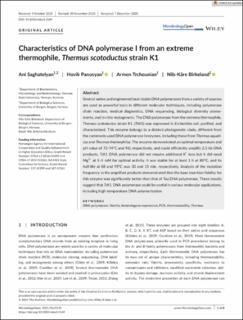Characteristics of DNA polymerase I from an extreme thermophile, Thermus scotoductus strain K1
| dc.contributor.author | Saghatelyan, Ani | |
| dc.contributor.author | Panosyan, Hovik | |
| dc.contributor.author | Trchounian, Armen | |
| dc.contributor.author | Birkeland, Nils Kåre | |
| dc.date.accessioned | 2021-12-15T14:51:25Z | |
| dc.date.available | 2021-12-15T14:51:25Z | |
| dc.date.created | 2021-04-21T13:49:46Z | |
| dc.date.issued | 2021 | |
| dc.identifier.issn | 2045-8827 | |
| dc.identifier.uri | https://hdl.handle.net/11250/2834536 | |
| dc.description.abstract | Several native and engineered heat-stable DNA polymerases from a variety of sources are used as powerful tools in different molecular techniques, including polymerase chain reaction, medical diagnostics, DNA sequencing, biological diversity assessments, and in vitro mutagenesis. The DNA polymerase from the extreme thermophile, Thermus scotoductus strain K1, (TsK1) was expressed in Escherichia coli, purified, and characterized. This enzyme belongs to a distinct phylogenetic clade, different from the commonly used DNA polymerase I enzymes, including those from Thermus aquaticus and Thermus thermophilus. The enzyme demonstrated an optimal temperature and pH value of 72–74°C and 9.0, respectively, and could efficiently amplify 2.5 kb DNA products. TsK1 DNA polymerase did not require additional K+ ions but it did need Mg2+ at 3–5 mM for optimal activity. It was stable for at least 1 h at 80°C, and its half-life at 88 and 95°C was 30 and 15 min, respectively. Analysis of the mutation frequency in the amplified products demonstrated that the base insertion fidelity for this enzyme was significantly better than that of Taq DNA polymerase. These results suggest that TsK1 DNA polymerase could be useful in various molecular applications, including high-temperature DNA polymerization. | en_US |
| dc.language.iso | eng | en_US |
| dc.publisher | Wiley | en_US |
| dc.rights | Navngivelse 4.0 Internasjonal | * |
| dc.rights.uri | http://creativecommons.org/licenses/by/4.0/deed.no | * |
| dc.title | Characteristics of DNA polymerase I from an extreme thermophile, Thermus scotoductus strain K1 | en_US |
| dc.type | Journal article | en_US |
| dc.type | Peer reviewed | en_US |
| dc.description.version | publishedVersion | en_US |
| dc.rights.holder | Copyright 2021 the authors | en_US |
| dc.source.articlenumber | e1149 | en_US |
| cristin.ispublished | true | |
| cristin.fulltext | original | |
| cristin.qualitycode | 1 | |
| dc.identifier.doi | 10.1002/mbo3.1149 | |
| dc.identifier.cristin | 1905614 | |
| dc.source.journal | MicrobiologyOpen | en_US |
| dc.identifier.citation | MicrobiologyOpen. 2021, 10 (1), e1149. | en_US |
| dc.source.volume | 10 | en_US |
| dc.source.issue | 1 | en_US |
Tilhørende fil(er)
Denne innførselen finnes i følgende samling(er)
-
Department of Biological Sciences [2225]
-
Registrations from Cristin [9688]

